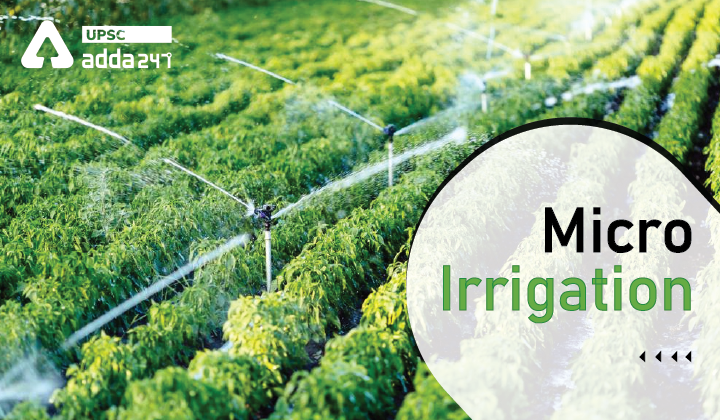Table of Contents
Micro Irrigation System
In the last article, we have discussed about irrigation and types of surface irrigation. In this article, we will discuss about micro irrigation is also called pressurized irrigation. We will also discuss the types of micro irrigation like drip irrigation and sprinkler irrigation. Micro irrigation topic is very important for UPSC exam and the aspirants must understand the micro irrigation topic comprehensively.
What is micro irrigation?
- Micro-irrigation system is a modern method of irrigation.
- In, this method water is irrigated through drippers, sprinklers, foggers and by other emitters on surface or subsurface of the land.
- Micro-irrigation system has become popular these days for its low cost and water-efficiency.
Types of micro irrigation system
- There are majorly 5 types of micro irrigation system. They are Drip irrigation, Sprinkler irrigation Spray irrigation, Subsurface irrigation, and Bubbler irrigation. For our purpose, however, we will restrict our discussion to drip irrigation and sprinkler irrigation that are important for UPSC exam.
Drip irrigation
- Drip Irrigation system is also known as Trickle Irrigation. It is the most widely form of Micro Irrigation System.
- In drip irrigation system, emitters directly deliver water to the plant root into the soil.
- These emitters optimize and distribute the water pressure from the water source using vents, twisters, and convoluted or long flow paths, which allows only a limited amount of water to pass through.
- The emitters can be placed either on the ground or also planted deep in the soil.
- The water flows through emitters moves with no barrier at the desired pace.
Advantages of drip irrigation
- Water saving and higher yield
- High quality and increased fruit size
- Suitable for all types of soil
- Easy method of fertigation and chemigation
- Saving in labour and field preparation cost
Disadvantages of drip irrigation
- High initial investment
- Clogging of emitters
- Possible damage of system components due to animals, etc.,
Sprinkler irrigation
- Under sprinkler irrigation, water flow passes around through a system of pipes mainly by pumping.
- It is then separated through sprinklers so that it splits up into tiny water drops that fall to the ground. Spray heads at the terminals distribute the water over the entire soil surface.
- It works in a pressurized form similar to natural rainfall.
- This form of irrigation provides water efficiently. In addition, this ensures improvement in crop yield.
- This method supplies the plant with the exact amount of water necessary for their optimum growth.
Advantages of sprinkler irrigation
- Suitable for all types of soil except for heavy clay.
- Saves up to 30% – 50 % of the water supply.
- Helps in boosting production with decreased labour cost.
- The system is easy to use because of its mobility
- Suitable for different land types and areas.
- Helps in the modification of microclimate
Disadvantages of sprinkler irrigation
- It’s usually affected by climatic conditions, water sources, and expense. Even mild breeze can severely decrease the effectiveness of Sprinkler Systems.
- When operating at high temperatures, water can evaporate at a fast rate degrading the effectiveness of the irrigation.
- It depends on a clean source of water and therefore may not be suited to areas where rainfall and groundwater sources are limited.
- Installation costs for Sprinkler Systems are also higher as compared to gravity-fed irrigation systems.
- Sprinklers have comparatively high energy demand, and thus it may not suitable for areas with limited or fluctuating power supply.
Read current affairs for UPSC





 TSPSC Group 1 Question Paper 2024, Downl...
TSPSC Group 1 Question Paper 2024, Downl...
 TSPSC Group 1 Answer key 2024 Out, Downl...
TSPSC Group 1 Answer key 2024 Out, Downl...
 UPSC Prelims 2024 Question Paper, Downlo...
UPSC Prelims 2024 Question Paper, Downlo...





